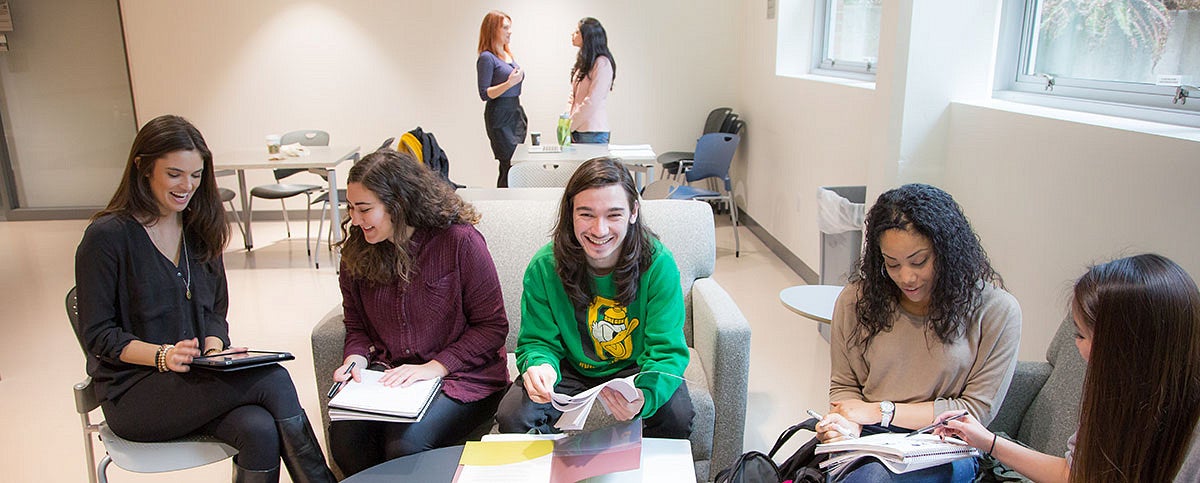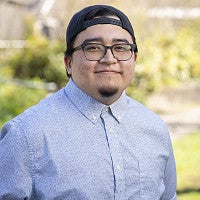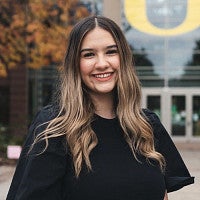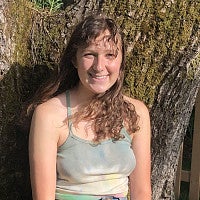
Between making friends, navigating campus, and adjusting to new academic rigors, the transition from high school to college can be overwhelming for many students.
At the UO, academic residential communities are helping freshmen ease that transition. ARCs, as they’re known, give students a place to live and learn with other students with similar interests, identities and majors.
“It’s creating that sense of belonging and that sense of community,” said Kevin Hatfield, assistant vice provost for undergraduate research and distinguished scholarships.
About 25 percent of incoming freshmen join one of the 15 ARCs at the UO. Students live together in the residence halls, and each ARC features a year-long, four-credit seminar that applies to students’ core education requirement.
Just as important as the academic aspect is the relationships ARC students develop with peers as well as faculty members and advisers.
“The opportunity to get to know, and be known by, faculty mentors early in their undergraduate careers helps create pathways for exploring and pursuing undergraduate research and creative work, study abroad and internships, distinguished scholarships and graduate school, and career development,” Hatfield said.
Many students who join ARCs begin making campus connections as high school seniors, Hatfield said, and they move in to residence halls early and participate in orientation together.
Creating those connections was was even more important during the first year of the pandemic because so much academic work was conducted remotely, Hatfield said.
Students who live on campus have higher grade-point averages, are more likely to return after freshmen year and graduate faster.
In some ways, ARCs are trying to recapture the kind of relationships that existed in an earlier era of higher education when faculty members lived on campus and were closer to students, Hatfield said.

While some ARCs are based around academic interests, a group of six communities are centered around ethnic, racial, gender, and/or cultural identities. The idea is to support traditionally underserved students, and first-generation college students, so they can succeed in college, he said.
“The ARCs foster relationships with a diverse community of faculty, staff, peer mentors, and community leaders committed to empowering students to navigate and thrive at the UO,” he said.
The identity-based ARCs work to unveil what is often referred to as a “hidden curriculum” or “insider knowledge,” which can create access and equity barriers at historically and predominantly white higher education institutions. Examples include learning how to engage in faculty office hours, working with faculty to get a letter of recommendation, seeking out opportunities to work in a lab or conducting undergraduate research.
The goal is to “change the institution so it’s designed for all students,” he added. “ARCs try to create that space that can break down some of those traditional barriers.”

Class of ‘21
ARC: Native American and Indigenous Studies
Major: Educational Foundations
White Lightning, a first-generation college student, came to the UO after growing up in Lawrence, Kan., as well as North Dakota, as a member of the Hunkpapa Lakota of the Standing Rock Sioux Tribe. Living in Lawrence, home to the University of Kansas, White Lightning said he was exposed to diversity, and was looking for a similar experience at the UO.
Native American faculty members reached out to him when he was admitted to the UO to help him get to know fellow Native American students and invited him to join the inaugural group of students in the Native American and Indigenous Studies ARC.
“It was small, and that really made things easier because we could have meaningful conversations about identity or what ever the topic was,” he said.
He moved from Hamilton Hall to Kalapuya Ilihi Hall, where the ARC was based, and started taking classes with other students in the group, which numbered about eight.
“I am extremely grateful I got to be a part of the ARC in general,” he said. “It really made coming from across country a lot easier. It made the transition easier because there were people who had similar upbringings and we would have the same understanding of the culture. It wasn’t hard to do small talk, just sharing stories right away and creating friendships and meaningful relationships.”

Rising sophomore
ARC: LatinX Scholars
Major: Psychology
A native of El Paso, Texas, Ramos said she knew she wanted to go out of state for college, and had fond memories of a trip to Oregon as a middle schooler.
“I figured college was the perfect opportunity to experience living somewhere else and learning new things,” she said.
Ramos heard about ARCs when she was applying for housing at the UO. The director of the LatinX Scholars ARC, Kelly Leon Howard, reached out and they talked about what it meant to be in the ARC, what resources would be available and what Ramos would get out of the experience.
When she got to Eugene, she moved into Bean Hall with a roommate who was also in the ARC, along with other members who were all on the same wing.
Coming from Texas to the UO in the middle of a pandemic “was a little isolating,” in part because classes were conducted remotely, making it hard to meet new friends, she said.
“I didn’t know anyone. I didn’t come in with a plan,” she said. Fortunately, she and her roommate, also from out of state, hit it off right away, she said. “We both knew what it was like to be so far from home.”
Ramos said her experience in the LatinX Scholars ARC provided a good foundation for the rest of her college career, “in all aspects, especially academics.”
Connecting with her advisor from the Center for Multicultural Academic Excellence was helpful as well.
“Advisers provide so much more than academic help,” she said. “They’re encouraging and supportive. They want you to feel welcome and want you to succeed. It’s nice to have that community.”
The social side of the ARC is important too, she said.
“I’ve met so many friends, so many people I’m going to continue having relationships with,” she said. “I’m really glad I was part of the ARC.”

Rising senior
ARC: Environmental Leaders
Major: Landscape architecture
As a high school student in Little Rock, Ark., Gastman knew she wanted to go out of state for college.
“I wanted to go somewhere that was environmentally inclined because that’s not really the culture where I’m from,” she said. “It’s something I came to care about and engage in, and I found that the UO had a lot of good programs for that.”
A neighbor from Little Rock told her about the Environmental Leaders ARC, so she joined the program. She wasn’t able to attend summer orientation, so she did an ARC orientation before classes started in the fall, which helped her get settled in at the UO.
“It was really nice to get acquainted with the Eugene surroundings as a whole and also meet some upper classmen who had gone through similar experiences,” she said. “It was really nice to get that perspective instead of just being immediately thrown into things. I was able to make some friends in a smaller environment.”
She and other members of the ARC lived together in Bean Hall, which was great for making new friends with a common theme.
“It was a perfect jump start to building really valuable friendships that I still hold with me,” she said. “It was like instant friends. I never felt lonely or uncomfortable. We all had that common care for the Earth.”

Class of 2021
ARC: Native American and Indigenous Studies
Major: Asian Studies and Indigenous Race and Ethnic Studies; Native American and Indigenous Studies minor
When Aisea came to campus for Duck Days with her mother, they visited the Center for Multicultural Academic Excellence, where they met with a Native American counselor, who strongly urged her to join a new ARC, Native American and Indigenous Studies.
“She said, ‘You’re coming in, you need to be in this ARC, this community of other Native American kids,’” Aisea said.
Aisea, who grew up partly in Portland and partly in the small town of Chiloquin, on the Klamath tribal reservation, was already familiar with campus: “I went to school with my mom when she was getting her degree.”
When Aisea’s mother, Natalie M. Ball, was an undergraduate, they lived in family housing on campus, and Aisea would attend some of her mother’s art classes, meetings and Native American Student Union powwows.
“I was immersed in her college experience,” Aisea said. “At the time I didn’t realize it, but it normalized academic education for me.”
She described her freshman year as “rough and rugged and really hard,” transitioning from a small high school in a rural community to college life in Eugene. Her ARC helped her make that transition, she said. Attending Native American Student Union meetings “kept me very grounded,” she said.
“My professors reached out to me a lot and really helped guide me even though I didn’t know what I was doing,” she said. “They gave me a lot of support. I have friends from the ARC to this day. I made lasting connections.”
Going to weekly Native American Student Union potlucks at the Many Nations Longhouse and hanging out with older Native American students was really important, she said.
“Looking back, it influenced me and helped get through a lot of things.”

